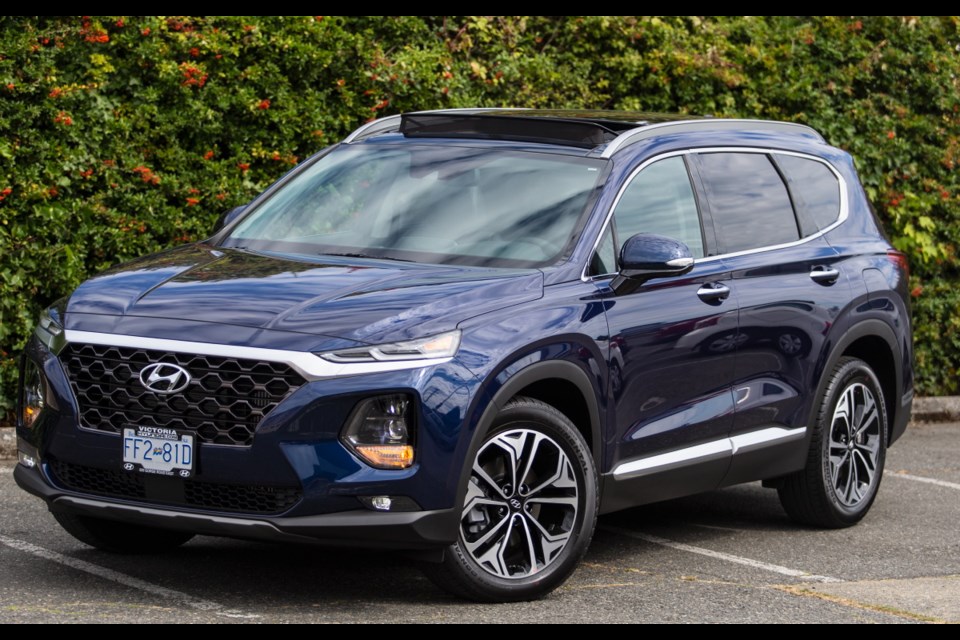The latest salvo for supremacy in the mid-sized SUV under $50,000 category has just been fired with the introduction of the 2019 Hyundai Santa Fe.
This is the fourth generation of the five-passenger mid-sized SUV, which replaces the outgoing Santa Fe Sport. For now, the seven-passenger model is only available in the older platform. It will be replaced by a new vehicle, under a new name, next year.
The Santa Fe has come a long way since 2000, when it was launched as Hyundai’s first SUV. Its popularity has contributed to the company’s overall success in the years it has been on the market.
There are seven different configurations to choose from, starting at $28,999 for the 2.4L Essential FWD. I drove the top-of-the-line 2.0T Ultimate Turbo AWD, with a list price of $44,999.
The 2019 Santa Fe builds on its success with a new body that is longer than the model it replaces, resulting to an increase in interior room.
The 2019 sits more upright as well, with Hyundai claiming 41 per cent more glass area than the outgoing vehicle. It makes for an airy cabin, even before the full-length panoramic sunroof found in our tester.
Getting into the Ultimate model is akin to a near-luxury experience. This vehicle has all the bells and whistles that you would expect from a luxury car — and more. There is an obvious attempt to impress with soft surfaces, upgraded materials and improved fit and finish.
The instrument binnacle brims with eye candy — and the ability to customize how you want to receive the information. The dash illumination changes from a green hue when in Eco setting, to blue for Normal driving and red in Sport mode.
These days many manufacturers offer a comprehensive suite of active and passive safety features. Hyundai has set the bar higher this year with the introduction of their Safe Exit Assist and Rear Occupants Alert.
The former uses sensors to warn of a car, motorcycle or bicycle approaching from the rear. It will keep the doors locked if there is potential for a collision (should the doors be opened) to prevent a crash.
The Rear Occupants Alert is geared toward preventing drivers from unintentionally leaving their children or pets in the back of the vehicle. The vehicle remembers if the rear doors have been used at the start of a trip. An ultrasonic sensor in the headliner detects movement in the rear of the vehicle after it has been parked. It then warns the driver, with either the horn honking repeatedly, or with a text or email on a connected smartphone via Hyundai’s Blue Link telematics system.
After witnessing near-misses with cyclists and vehicle doors or reading about tragic consequences of leaving a child in a car all day, I suspect these two features will find widespread appeal. The hope is that other manufacturers will also incorporate them in their future vehicles.
The body might have received extensive upgrades, but under the hood much remains the same. The Santa Fe is available with two familiar four-cylinder engines, the base motor a naturally aspirated 2.4-litre producing 186 horsepower and 178 pound-feet of torque.
The optional engine (and the one found in my tester) is a turbocharged 2.0-litre four producing 235 hp and 260 lb.-ft. of torque.
Both are mated to a new, Hyundai-designed, eight-speed automatic transmission (up two gears from last year). Depending on the trim, you can choose between front- and all-wheel-drive configurations.
The turbo is the engine of choice for the Santa Fe, with strong acceleration and minimal turbo lag off the line. It is responsive, especially when set to Sport mode. An engine stop/start feature in Eco mode helps eke out the best fuel economy.
Handling is better than average, with agile handling thanks to my tester riding on larger 19-inch tires.
The Santa Fe’s ride has always been good, but the new model has a more refined (if a touch firm) ride, with a suspension capable of smoothening out rough surfaces and road noise.
People who have difficulty getting in and out of vehicles will appreciate the Santa Fe’s ample doors and hip-height seats. For most people, one only needs to back into the wide front seats — no need to climb up or drop down.
Although there is a plethora of controls awaiting the driver, they are mostly intuitive and simple to interpret, a welcome change from the complexity of some other manufacturers.
The redesigned Hyundai Santa Fe has once again set the bar high in the mid-sized SUV segment. Its mix of competitive prices, attractive convenience features, comfort and unique safety features (including the Safe Exit Assist and Rear Occupants Alert) now form the new benchmark for other manufacturers to attain.
THE SPEC SHEET
Type: Mid-sized SUV, front engine, all-wheel-drive
Engine: Turbocharged 2.0-litre four cylinder, 235 hp at 6,000 r.p.m., 260 lb.-ft. of torque at 1,450 to 3,500 r.p.m.
Transmission: Eight-speed automatic
Dimensions (mm): Length, 4,770; width, 1,890; height, 1,705; wheelbase, 2,765
Curb weight (kg): 1,853
Price (base/as tested): $44,999/ $47,004 (includes $1,905 freight and PDI and $100 AC tax)
Options: Nil
Tires: 235/55 R 19 on alloy wheels
Fuel type: Regular
Fuel economy (L/100km): 12.3 city/ 9.8 highway
Warranty: Five years/100,000 km new car



